Epson EcoTank L555 Review
Epson EcoTank L555
A printer with all the ink you’ll need for two years or more, without cartridges
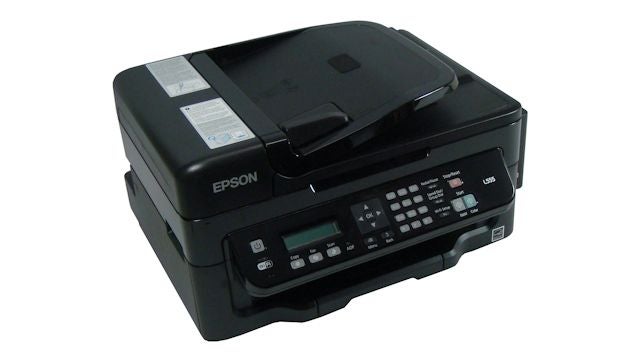
Sections
- Page 1 Epson EcoTank L555 Review
- Page 2 Print Speeds and Costs Review
Verdict
Pros
- Easy maintenance
- Fax built in
- Low power consumption
Cons
- Very slow copying and colour print
- No duplex
- No borderless photos
Key Specifications
- Review Price: £330.00
- Supplied Ink for up to 6500 pages
- Ink for next 6500 pages just £36
- Wi-Fi
- Direct Android/iOS print
- Straightforward controls
What is the Epson EcoTank L555?
Epson has been listening to its customers, who’ve been chanting the inkjet owner’s chant: ‘Why does ink cost so much?’ In fact, inkjet ink is generally cheaper per page than laser toner, but the smaller capacity of inkjet cartridges means you run out more often.
So Epson has reversed the printer/ink paradigm and introduced the EcoTank range. As the name suggests, it’s dispensed with cartridges and instead produced two printers, the EcoTank L355 and the EcoTank L555, reviewed here, which use tanks of ink, in hook-on modules attached to their sides.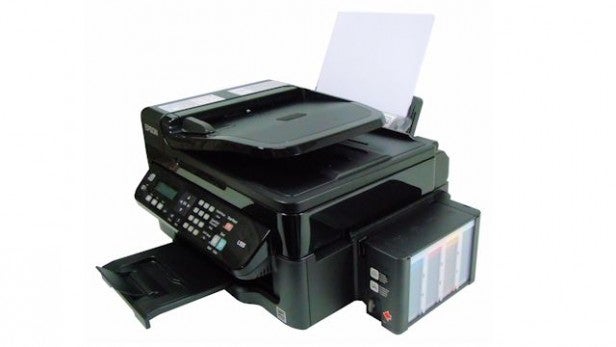
The tanks are directly connected to the printer’s heads via flexible tubes and can take up to 70ml of ink at a time, enough for 4000 black pages and 6500 colour ones. The printers are aimed at the small or home office printing around 150 pages per month, so should last two years or more.
SEE ALSO: Best Wireless Routers Round-up
Epson EcoTank L555 – Design and Features
Apart from the tank module, the Epson EcoTank L555 is a conventional enough all-in-one, with a 30-sheet Automatic Document Feeder (ADF) on top. The wide control panel is logically laid out, but only sports a 2-line by 16-character LCD screen. This precludes previewing photos for printing, but then this isn’t a photo printer, has no card or USB slots in the front panel and can’t produce borderless prints.
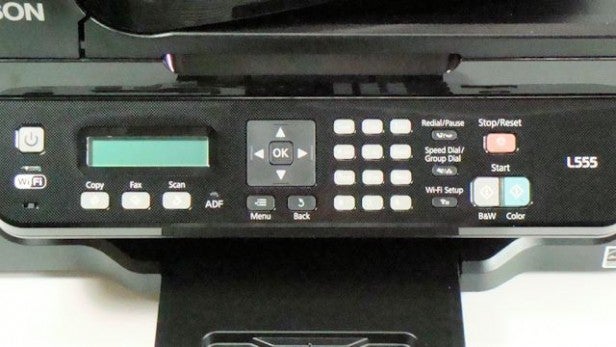
There’s a single paper tray, which can hold up to 100 sheets, angled nearly vertically at the back. Connection is either via a single USB socket at the rear or by a Wi-Fi link, which is easy to set up and more versatile. Apart from the ink tanks, the machine bears quite a bit of resemblance to the £100 WorkForce WF-2630WF.
Epson EcoTank L555 – Cartridge Installation
Setting up the printer takes a bit longer than clipping in cartridges, but only has to be done every two years or so. Unhook the tank module from the side of the printer and turn it on its side. Open each of the tanks by removing a plug and squeeze the contents of an ink bottle into each one. It’s quite tricky not getting ink on yourself when you peel the seals from the necks of the bottles.
Epson EcoTank L555 – Print Speeds
Even though Epson now uses the
ISO standard for measuring print speed, it speeds can still be
ambitious when compared with real-world tests. The EcoTank L555 is rated
at 9ppm for black print and 5ppm for colour and it got quite close in
our mono print tests, with 7.8ppm for a 20-page document, dropping to
7.3ppm with the more normal 5-page document.
However, the colour
test, again five pages, only gave 2.5ppm, just half of the claimed
figure. It took over 2 minutes to print, but this is still quite a bit
quicker than the 2:40 (less than 2ppm) it took to copy a 5-page mono
document from the ADF.
It took over 2 minutes to print a 15 x 10cm colour photo in best print quality, too, but improved on this to 1:13
in normal mode, printing from a Samsung Galaxy S3 smartphone.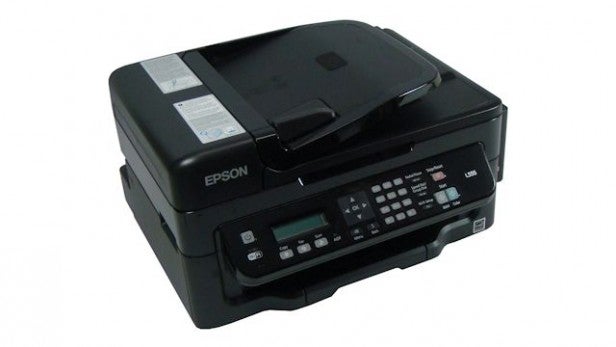
Epson EcoTank L555 – Print Quality and Costs
The
output quality is very similar to that from Epson printers using
conventional cartridges, probably because the print heads are the same.
Black text is good quality, though not as sharp as from Canon and HP’s
thermal inkjets, and colours on plain paper aren’t as bright. Text over
colour is well registered and photo prints are of very high quality, as
is normal for Epson machines.
As you would expect, the EcoTank
L555 excels in its running costs. Printing 4000 pages from a £9 black ink bottle
gives a mono page cost of 1.1p, including 0.7p for paper. Colour print
is not much more expensive at 1.5p, with the same paper cost. It whomps
the page costs of any other laser or inkjet all-in-one at the price. 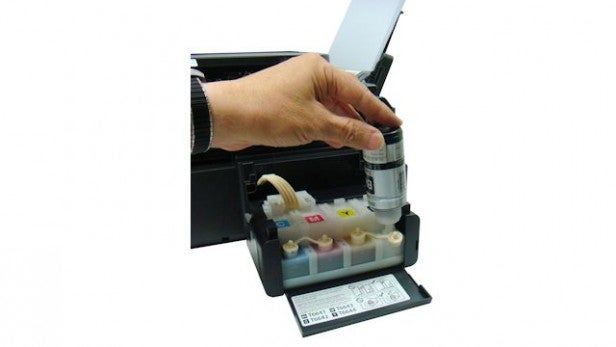
Should I buy an Epson EcoTank L555?
You
could look at the cost of this machine as a £100 printer and a £36 set
of ink bottles and wonder where the other £200 comes from, but that
would probably be naive. The current paradigm for inkjet sales is to
sell the printer cheap and make money on the cartridges. Epson’s been quite
brave to turn this on its head and offer ink at realistic prices, but to
do this it has to charge a more realistic price for the printer.
There’s
very little to compare this machine to at the price, mainly because
inkjet printers with a similar feature set cost around £100. If you add the cost of the ink to print the same number of pages as the EcoTank
L555 can, you start to see the savings.
Taking Epson’s own
WorkForce WF-2630WF as a comparison and adding the cost of cartridges to
print 4000 mono pages and 6500 colour ones gives a total of just
under £800. This would be similar if you used a rival machine and its
cartridges.
SEE ALSO: Best Printers Round-up
Verdict
If low running cost is your primary
requirement and you have £350 to spend upfront, the EcoTank L555 is a
brilliant all-in-one. However, if you want duplex print or to print
borderless photos, you’ll be out of luck and the speed of the machine,
particularly when printing in colour on plain paper or copying from the
ADF, is poor.

